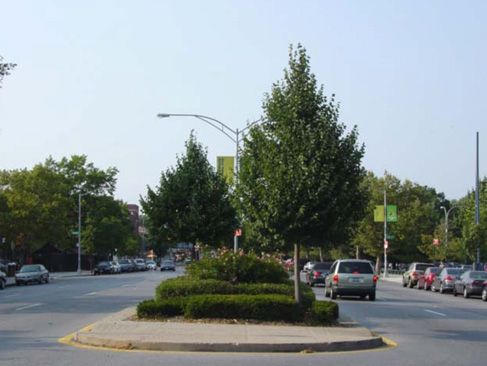Feds Give Nearly $1 Million For Brighton Beach Greenstreets As Coastal Resiliency Measure

The Department of Interior is sending $990,000 to the New York City Parks Department to create approximately 14 greenstreets throughout Brighton Beach, intended to help dry out the streets in a future flood, as part of the Sandy Coastal Resiliency grants awarded earlier this week.
Greenstreets is a citywide program to convert paved, vacant traffic islands and medians, as well as portions of wide sidewalks, into landscaped spaces. According to the Parks Department:
The installation of approximately 14 greenstreets in Brighton Beach will mitigate localized flooding and capture and filter stormwater runoff, thereby helping to reduce pollutants from entering local waterways. The project will also help to beautify the neighborhood, lower temperatures, increase biodiversity in the area, and improve air quality.
The funds are part of $15 million in grants being doled out in New York City through the Department of Interior as part of a competition to make coastal communities more resilient to flooding.
Other winning projects from the Department of Interior competition include salt marsh restoration at Spring Creek, and oyster bed restoration throughout Jamaica Bay.
“This announcement is great news for the communities surrounding many New York City waterways, like Brighton Beach, Broad Channel, Spring Creek Park, Tibbetts Brook and Jamaica Bay, because they will now be better protected in the event of a future storm,” said Senator Charles Schumer in a press release. “This resiliency grant funding is just what we had in mind when crafting the Sandy Relief Bill and I’m pleased that the Department of Interior has recognized these critical projects in New York City.”
If successful in helping drain storm runoff, the Brighton Beach greenstreets plan may later be expanded throughout the Coney Island peninsula and Jamaica Bay communities.
But at least one environmental activist and Brighton Beach resident wonders whether the greenstreets project will be as effective as Schumer and the Parks Department say, and thinks it might be poised for failure.
Ida Sanoff,
executive director of the Natural Resources Protective Association, said the water table is much too high on the peninsula to allow proper drainage. She wrote:There is one teeny, tiny little problem in Coney Island that makes me wonder if these highly paid consultants ever went down there: The water table. EVERYONE in Coney and Brighton, including my cat, knows that the water table varies from 3 to 5 feet below the surface. In some locations, it is mere inches from the surface. In Seaside Park, where the majority of the surface is unpaved, the Parks Dept. put in retention basins, which promptly filled with salt water from the ground. There are some areas in this park that are virtual lakes for weeks after every rain event, because a few inches below the surface, there is water.
Sanoff adds that after a heavy rain, water collects and “ponds” on the surface of soil, creating prime habitat for mosquitos.
“Without proper maintenance, the tree pits become little more than doggie toilets,” she said.
Asked if the department had taken the water table into consideration when creating their proposal, a Parks spokesperson told Sheepshead Bites that no specific locations had yet been identified, and that the department will do more detailed surveys before doing any construction.
The spokesperson added that the number of streets to be landscaped is still up in the air, but based on previous projects the funding should cover approximately 14.
The greenstreet plan was first outlined in the New York City Special Initiative for Rebuilding and Resiliency (SIRR) plan, a blueprint for strengthening the city from the threat of rising sea levels and climate change in the wake of Superstorm Sandy. The latest version of the plan can be read here.



